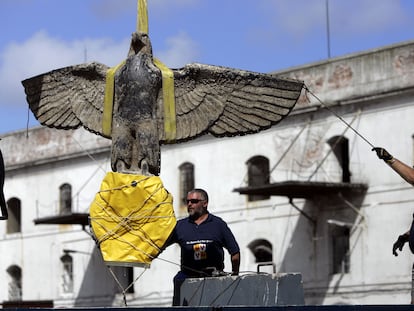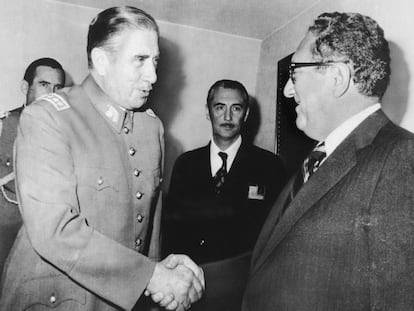Vicente Muñiz, the Mexican ambassador who gave refuge to 400 people during the Uruguayan dictatorship
Half a century ago, the diplomat provided shelter in Montevideo to those in peril following the coup, and his memory lives on today for those he saved
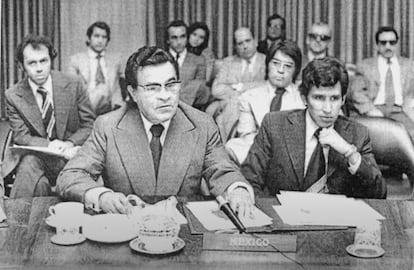
Vicente Muñiz Arroyo, Mexico’s ambassador to Uruguay from 1974 to 1977, had a message for his staff: “Asylum seekers must first be given protection; the question of granting asylum shall follow in due course.” The South American country was in crisis and he knew it was time to act. With Juan María Bordaberry’s military-supported dictatorship in power, hundreds of regime opponents faced torture, imprisonment and even death. During his three years in charge of the Mexican Embassy, Muñiz opened his home to around 400 people, processing safe-conduct permits and arranging flights that took hundreds of exiles to Mexico.
Growing up in Churintzio, a town in the Mexican state of Michoacán, his childhood home always welcomed visitors with open doors, showing kindness and generosity to anyone in need. In 1965, Muñiz Arroyo arrived in Montevideo as Mexico’s representative to the Latin American Free Trade Association (ALALC) after earning an economics degree from the National Autonomous University of Mexico. In this role, Muñiz successfully brokered key trade agreements between both nations. In 1974, he was appointed ambassador to Uruguay during one of the country’s darkest periods when the repressive dictatorship forced almost 10% of its citizens to flee the country.
The Southern Cone region saw the rise of guerrillas and dissidents who opposed the severe repression of national security policies often dictated by the White House. Simmering tensions soon led to a full-blown coup in the country. Two years later, in November 1975, Uruguay officially joined the Operation Condor, a military “collaboration” by Argentina, Chile, Uruguay, Bolivia, and Paraguay to persecute, disappear and torture their main enemy: communists. Uruguay legalized physical and psychological torture in addition to state terrorism. President Bordaberry faced growing unrest fueled by various opposition groups, particularly the National Liberation Movement (Tupamaros), an armed faction founded in 1963 with a mission to institute a new order through force. The U.S. government carefully monitored the situation, wary that the Cuban Revolution in 1959 could embolden radicalism that threatened its political and economic interests in the region.
Uruguyanas lived in fear amid the constant patrolling of security forces. Clara Emilia Puchet, a teacher and biologist from the city of Durazno, was one of the 400 people who was given shelter and protection by Ambassador Muñiz. She was 16 years old when the coup happened. “It was a terrifying time for the country. They could detain anyone for any reason. Being young and a student was a serious offense according to the regime,” Puchet told EL PAÍS. Her father, journalist Carlos Puchet, was the first person to seek asylum in the Mexican Embassy when his home was raided in October 1975. Carlos wasn’t there at the time, but his wife, Emilia Anyul, and their two daughters, Clara and Ana, were home when the military seized the house for three days. “We have visitors,” Emilia told her husband by phone. That was the code to let him know the authorities were at the house. The journalist holed up in the ambassador’s residence for over a month.
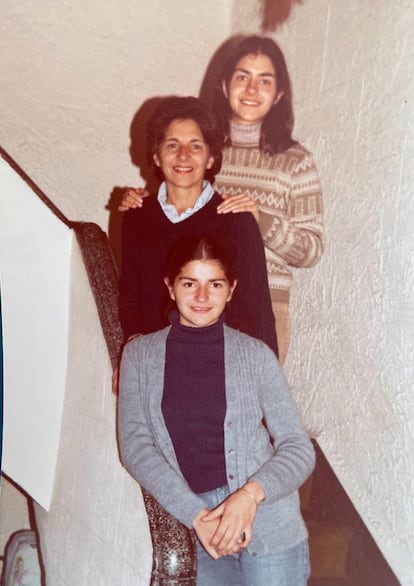
In November 1975, Emilia, Clara, and Ana received an unexpected summons from Muñiz. It was time for their father to leave for Mexico. Emilia and the sisters were surprised to hear from the ambassador that they too would have to go into exile, as their lives were in peril. At first, Emilia didn’t see the need for such a drastic measure. She thought they could continue living their lives as normal, despite her husband’s absence. “The repression only intensified,” said Clara. “After my father left for Mexico, my sister was kidnapped and tortured. When my mother managed to get her out, we left our home and started moving from place to place to avoid detection. We were at a beach called Piriápolis, when people from the Mexican Embassy came to tell us that the army was coming after us and we had to seek refuge in the embassy right away.” With nothing but the few belongings they had taken for a day at the beach, they headed to the ambassador’s residence in Montevideo. They lived there for 65 days.
Arriving at the Mexican Embassy
Although Ambassador Muñiz personally sought out a few people threatened by the regime, most of those he helped came to him seeking asylum. José Luis Blasina, an 87-year-old from Montevideo, was a trade unionist affiliated with the Uruguayan Socialist Party in the early 1970s. On the day of the coup, he was arrested and imprisoned for two months. As the repression escalated, Blasina was compelled to leave his spouse and children and seek asylum in the Mexican Embassy in September 1976. “I felt like they were right on my heels,” he told EL PAÍS. “I had to rush to the [Mexican] embassy, which I knew was the only one taking in people. The building was surrounded by military and police officers. I don’t know how I got through — I caught them off guard for a moment.”
The ambassador and his driver would take asylum seekers to his residence in his car, protected by diplomatic immunity. But with Blasina and three others in the car, the entrance to the ambassador’s residence was blocked by a group of soldiers who commanded the driver to stop. Muñiz ordered him to accelerate, forcing the soldiers to jump out of the way. The four asylum seekers arrived safely at their new home.

At its peak, up to 200 people were living in the ambassador’s official residence. Silvia Dutrénit, a historian from Montevideo who settled in Mexico in 1976, has written numerous accounts of Muñiz’s efforts to protect people from the Uruguayan regime. Dutrénit left her homeland and eventually arrived in Mexico under the auspices of the United Nations High Commissioner for Refugees (UNHCR). The historian says there isn’t an exact record of how many Uruguayans sought asylum in Mexico, as many didn’t follow the proper procedures to enter the country. According to Dutrénit, a distinguishing characteristic of the Uruguayans seeking asylum in Mexico was the time they spent in the Mexican Embassy in Montevideo. An astounding 95% had lived in Ambassador Muñiz’s residence.
Dutrénit says that very few embassies opened their doors to people in danger, and the ones that did, like Colombia and Venezuela, took in very few people. “But Muñiz Arroyo was different. He welcomed everyone who came and didn’t wait for official asylum requests. That sensitivity was one of his characteristics, along with his immense generosity and courage,” said Dutrénit. In 2010, the historian directed Más allá del reglamento (or, Breaking the Rules), a documentary about the diplomat’s life and the experiences of some of those who took refuge in his residence.
Jose Carlos Fazio Varela was born in 1948 in Montevideo. He was 24 when he left Uruguay alone, one night after security forces detained him for no cause. Like Dutrénit, he made it to Argentina where he sought help from the UNHCR. Juan Domingo Perón died in 1974 while Fazio was there, and then came the military coup led by Jorge Rafael Videla. Fazio realized he had to leave Argentina and finally arrived in Mexico on August 6, 1976, as a refugee. He was helped by a group of Uruguayan exiles, the Mexican consulate in Argentina and Ambassador Muñiz, whom he later wrote about. “As Mexico’s Ambassador to Uruguay, he provided asylum to many persecuted individuals. He joins the esteemed ranks of Mexican diplomats, including Gonzalo Martinez Corbala, Luis I. Rodriguez, Gilberto Bosques and Isidro Fabela, who all upheld Mexico’s creed that freedom is the greatest treasure of all.”
Normalcy amid uncertainty
Thirty people were already taking refuge at the ambassador’s residence when Clara Puchet arrived with her mother and sister. During their 65 days there, the number had risen to over 100. Apart from Uruguayans, the group also included exiles from Paraguay and Brazil. Muñiz gave up his entire home to accommodate more people. Dozens of mattresses covered the floors at night and were put away in the morning to accommodate daily activities. Various work groups were organized for cleaning, cooking and teaching. Clara and her sister offered French classes, while others taught painting, music, history and computer skills. The house even had a makeshift school for the children. The goal was to establish normalcy amid the uncertainty.
Vicente Muñiz offered everything he had to the asylum seekers. Gustavo Maza, the embassy’s First Secretary from 1973 to 1976, recalls in the documentary how the diplomat made his guests’ daily lives more bearable. “He gave away his house, dishes, records, clothes, bed, sheets — everything. He was left with nothing,” said Maza, adding that Muñiz never submitted his expenses to the Foreign Ministry in Mexico for reimbursement. He paid for everything out of his own pocket.

No one could leave. The house was permanently guarded by Uruguayan security forces. José Luis Blasina remembers the constant fear of someone coming to take them away. Despite the hardship, the diplomat’s compassion made life easier for everyone. “I was staying in this huge house with around 200 people. It was definitely a test, but we all managed to live together in harmony,” he recalls. Muñiz never missed a chance to celebrate. Whenever a child had a birthday, the ambassador threw a party complete with balloons, cake and presents. He even made sure every child received a gift during Three Kings Day festivities.
Whenever the Uruguayan government issued a permit for a refugee to leave the country, Muñiz would throw a farewell party. “They played Mexican music and served drinks,” said Blasina. The ambassador always gave farewell gifts to those heading to Mexico. He not only escorted them to the airport but also boarded the plane to make sure there were no last-minute problems.
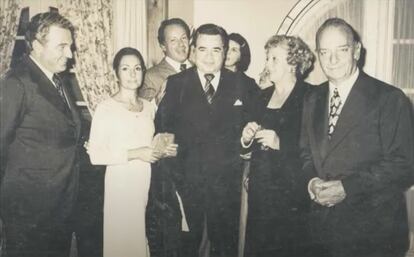
The exiles traveled in groups to Mexico City, where the Ministry of the Interior received, interviewed and housed them temporarily in hotels. Clara Puchet clearly remembers how she felt the day they arrived in the Mexican capital. “We arrived on March 26, 1976. I thought it was a very colorful and enormous city, especially for someone from Montevideo. There’s so many people in Mexico City — we had never seen crowds like that on the streets. In Uruguay, those crowds would only gather for demonstrations,” said Puchet.
Vicente Muñiz was removed as Ambassador to Uruguay in 1977. President José López Portillo assigned the post to Colonel Rafael Cervantes Acuña, who terminated diplomatic asylum in the Mexican Embassy. Silvia Dutrénit says there was a strategy to end the open-door policy of Mexican embassies in South America.
The dictatorship in Uruguay lasted until March 1, 1985, when democracy was restored. After the announcement by President Julio Maria Sanguinetti of the amnesty law that freed 200 political prisoners, thousands of exiles like Blasina were able to return home. Carlos Fazio returned as a correspondent for Proceso, the Mexican news magazine founded by Julio Scherer. However, others like the Puchet and Dutrénit families chose to remain in the countries that gave them new lives.
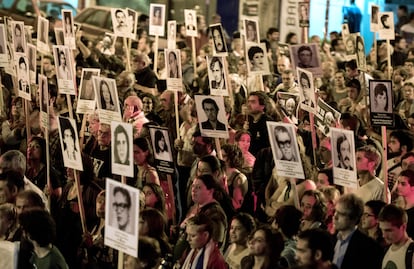
In 1987, Muñiz returned to Uruguay as Mexico’s representative to the Latin American Integration Association, a regional organization promoting socio-economic development. He lived in Uruguay until his death on August 23, 1992. There is a monument in his honor on Montevideo’s La Rambla Avenue, across from Plaza de la Armada. The plaque reads, “Don Vicente Muñiz Arroyo fiercely defended democracy and unwaveringly upheld the right of asylum, safeguarding freedom and saving countless lives of those persecuted during the dictatorship.”
Sign up for our weekly newsletter to get more English-language news coverage from EL PAÍS USA Edition
Tu suscripción se está usando en otro dispositivo
¿Quieres añadir otro usuario a tu suscripción?
Si continúas leyendo en este dispositivo, no se podrá leer en el otro.
FlechaTu suscripción se está usando en otro dispositivo y solo puedes acceder a EL PAÍS desde un dispositivo a la vez.
Si quieres compartir tu cuenta, cambia tu suscripción a la modalidad Premium, así podrás añadir otro usuario. Cada uno accederá con su propia cuenta de email, lo que os permitirá personalizar vuestra experiencia en EL PAÍS.
¿Tienes una suscripción de empresa? Accede aquí para contratar más cuentas.
En el caso de no saber quién está usando tu cuenta, te recomendamos cambiar tu contraseña aquí.
Si decides continuar compartiendo tu cuenta, este mensaje se mostrará en tu dispositivo y en el de la otra persona que está usando tu cuenta de forma indefinida, afectando a tu experiencia de lectura. Puedes consultar aquí los términos y condiciones de la suscripción digital.
More information
Archived In
Últimas noticias
Maduro counterattacks Trump with rhetoric and announces downing of nine drug trafficking aircraft
‘Ecce Homo’: The miraculous disaster that made a small Spanish town famous
Return to sex testing at the Olympics: IOC edges closer to banning transgender women
Trump escalates conflict with Venezuela with the start of covert operations
Most viewed
- Sinaloa Cartel war is taking its toll on Los Chapitos
- Oona Chaplin: ‘I told James Cameron that I was living in a treehouse and starting a permaculture project with a friend’
- Reinhard Genzel, Nobel laureate in physics: ‘One-minute videos will never give you the truth’
- Why the price of coffee has skyrocketed: from Brazilian plantations to specialty coffee houses
- Silver prices are going crazy: This is what’s fueling the rally
